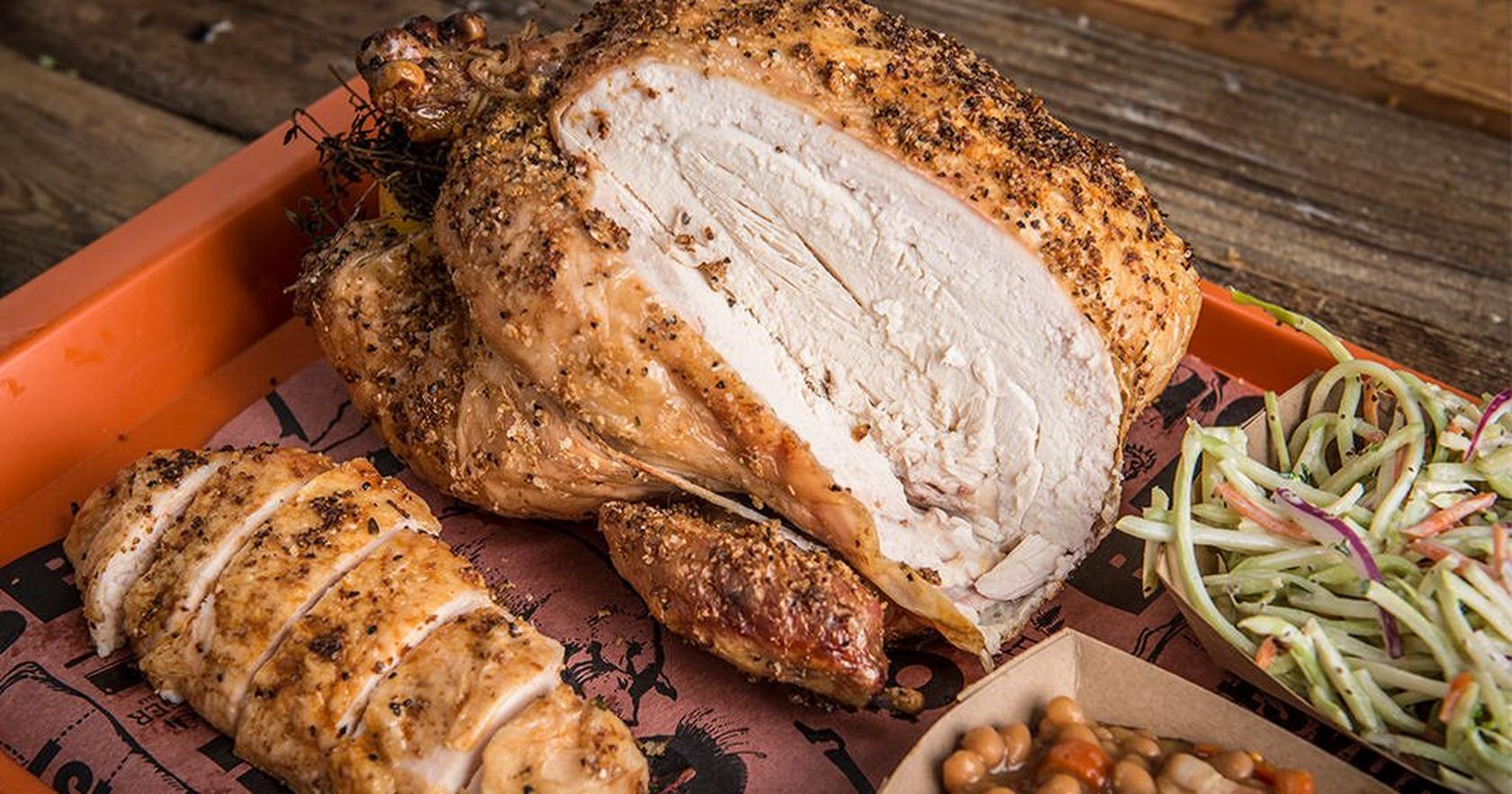
Cooking meat properly can take a long time -- especially when you’re grilling low and slow. That’s why it can be pretty tempting to simply call it quits and plate up without bothering to check your meat temperatures.
Do yourself a favor and exercise some self-control. You don’t want to play around when it comes to cooking times or safe serving temperatures because you could end up getting yourself and your friends and family sick.
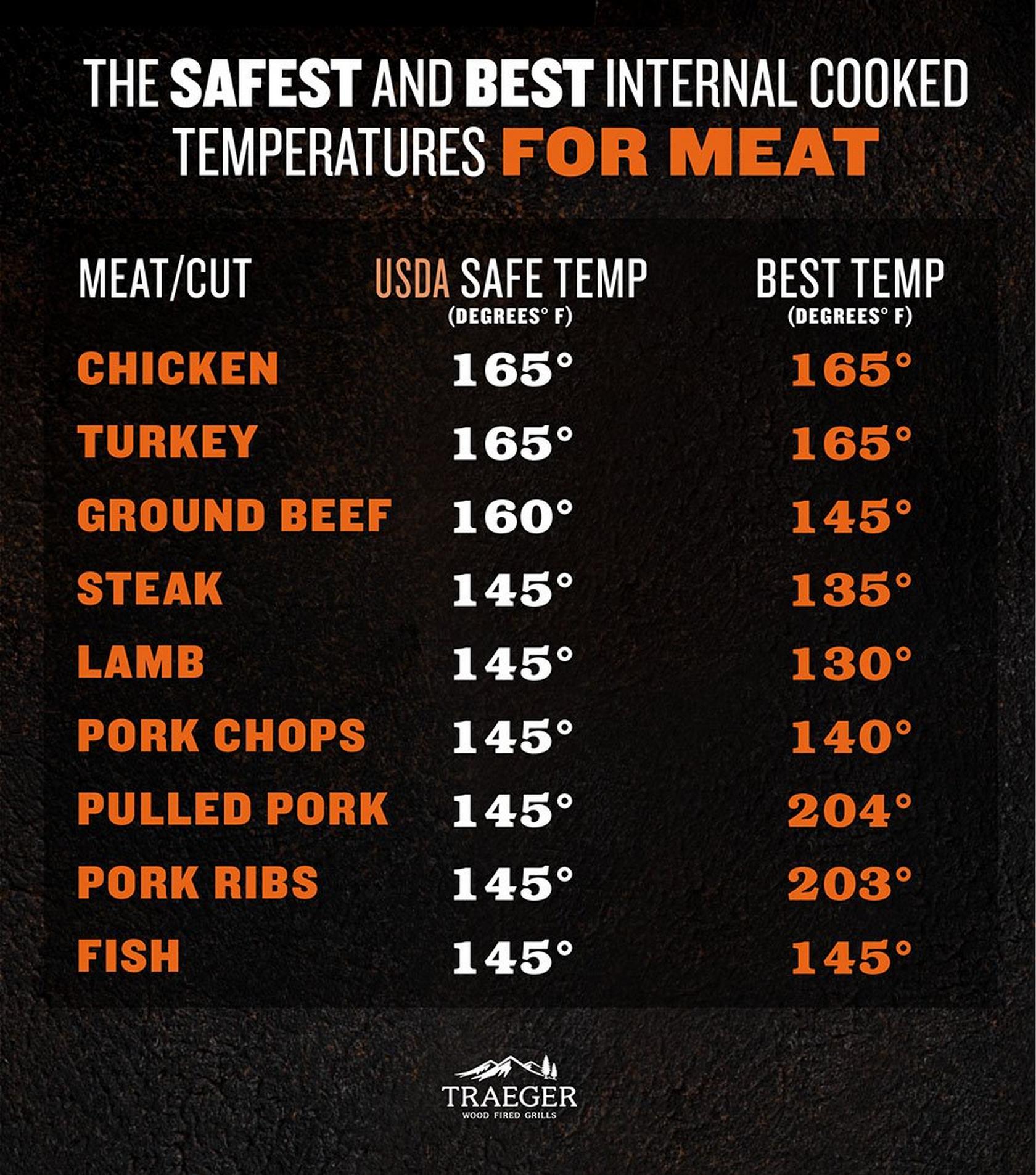
The USDA has internal temperature guidelines for a reason, and appearance and color aren’t necessarily reliable indicators of safety -- so you really need to arm yourself with all the facts before firing up the grill.
Before we dive into the facts, it’s worth mentioning that there are a few shades of gray.
“Doneness” and “safe” are two totally different concepts, and there are a few cuts and types of meat that a lot of seasoned grillmasters are comfortable undercooking (or even overcooking) a tiny bit in the name of flavor or texture. We’ll get to that in a minute.
First, let’s look at the government’s advice on safe serving temperatures for meat.
What Temperature Should Meat Be Cooked To?
Different types of meat should be cooked at different temperatures depending on the size and type of your cut and your cooking method. But, whether you're roasting, grilling, or even boiling a piece of meat (please don't), you have to get it to a certain internal temperature before it's safe to serve. That's why you should always use a MEATER wireless meat thermometer to ensure you’ve reached a safe serving temperature.
The USDA recommended safe serving temperature for your most common cuts starts at 145 degrees Fahrenheit and goes up to around 165 degrees Fahrenheit. Again, this all varies based on the type of meat.
To help you home in on the exact temp you need, we’ve broken down the USDA guidelines into quick, bite-sized chunks.
What Is the Safe Internal Temperature for Chicken?
The USDA-recommended safe serving temperature for chicken is 165 degrees Fahrenheit. This is internal temperature we’re talking about -- and there’s no wiggle room when it comes to undercooking poultry. You do not want to undercook chicken. Stick with the USDA recommendation of 165 degrees.
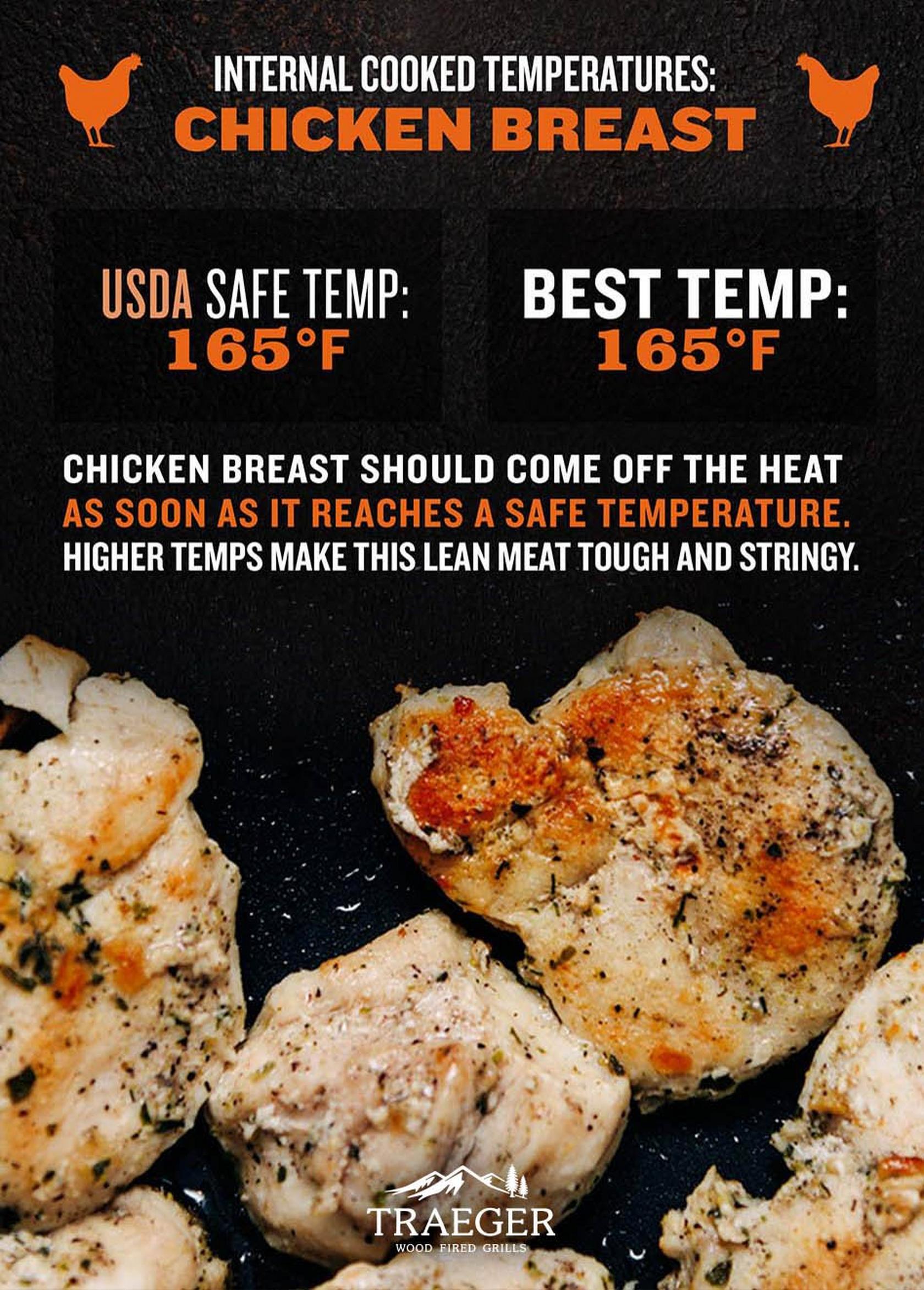
This temperature applies to both whole and ground chicken.
To make sure you’ve reached the safe serving temperature for chicken, you’ll need to use a MEATER wireless meat thermometer. Place it in the innermost part of the thigh, the innermost part of the wing, and the thickest part of the breast. Your bird is safe to take off the grill after you’re reading 165 degrees in all three areas.
If your chicken is stuffed, you also have to check the internal temperature of your stuffing to make sure it’s fully cooked. Again, the center of your stuffing needs to reach 165 degrees Fahrenheit.
What Is the Safe Internal Temperature for Turkey?
The recommended safe serving temperature for turkey is 165 degrees Fahrenheit, too. As a frame of reference, this USDA internal temp of 165 degrees is the same for all poultry which makes it easier to remember.
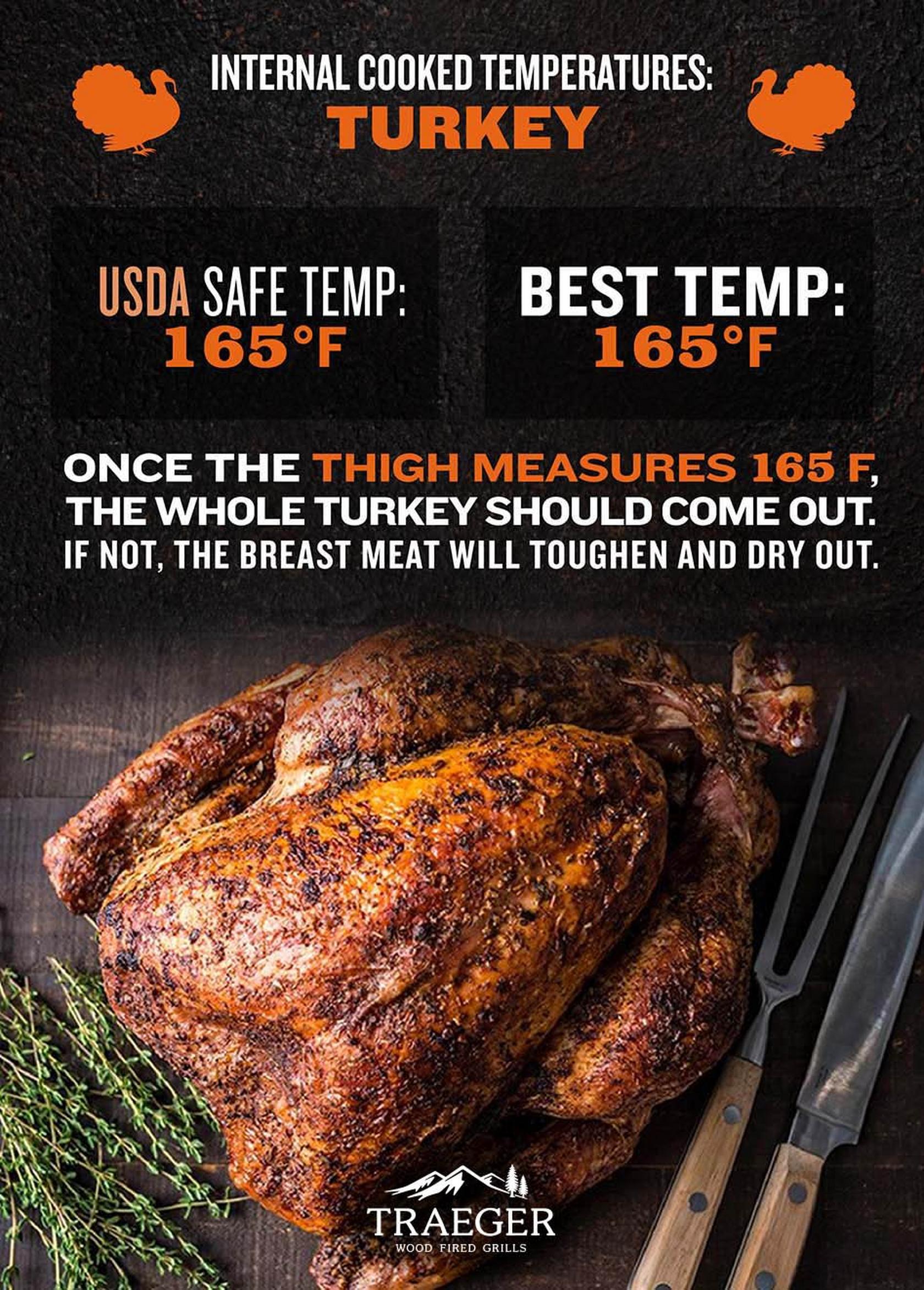
This safe serving temperature applies to both whole and ground turkey.
Check that your turkey is ready to serve by using a MEATER 2 Plus meat thermometer. Place your thermometer in the thickest parts of the bird’s wing, breast, and wing. All three areas have to show a reading of 165 degrees Fahrenheit before you’re okay to take the bird off the grill.
The same temperature rule applies to stuffing. If your turkey has been stuffed, use a thermometer and check the center of your stuffing to make sure you’ve hit that 165-degree mark.
If your turkey came with a pop-up temperature indicator, it’s helpful as a guide. But those cheap pop-up thermometers don’t give you a full picture in terms of your safe serving temperatures because they aren’t normally designed to reach the innermost part of a large turkey’s thigh or breast. When in doubt, always back up the reading on your pop-up indicator with a proper meat thermometer.
For a perfectly grilled (and safe) bird, we recommend our Thanksgiving Turkey Grill Guide.
What Is the Safe Internal Ground Beef Temperature?
For ground beef, the USDA recommends a safe serving temperature of 160 degrees Fahrenheit. But ground beef is one type of meat where experienced cooks take a bit of liberty when it comes to safe serving temperatures.
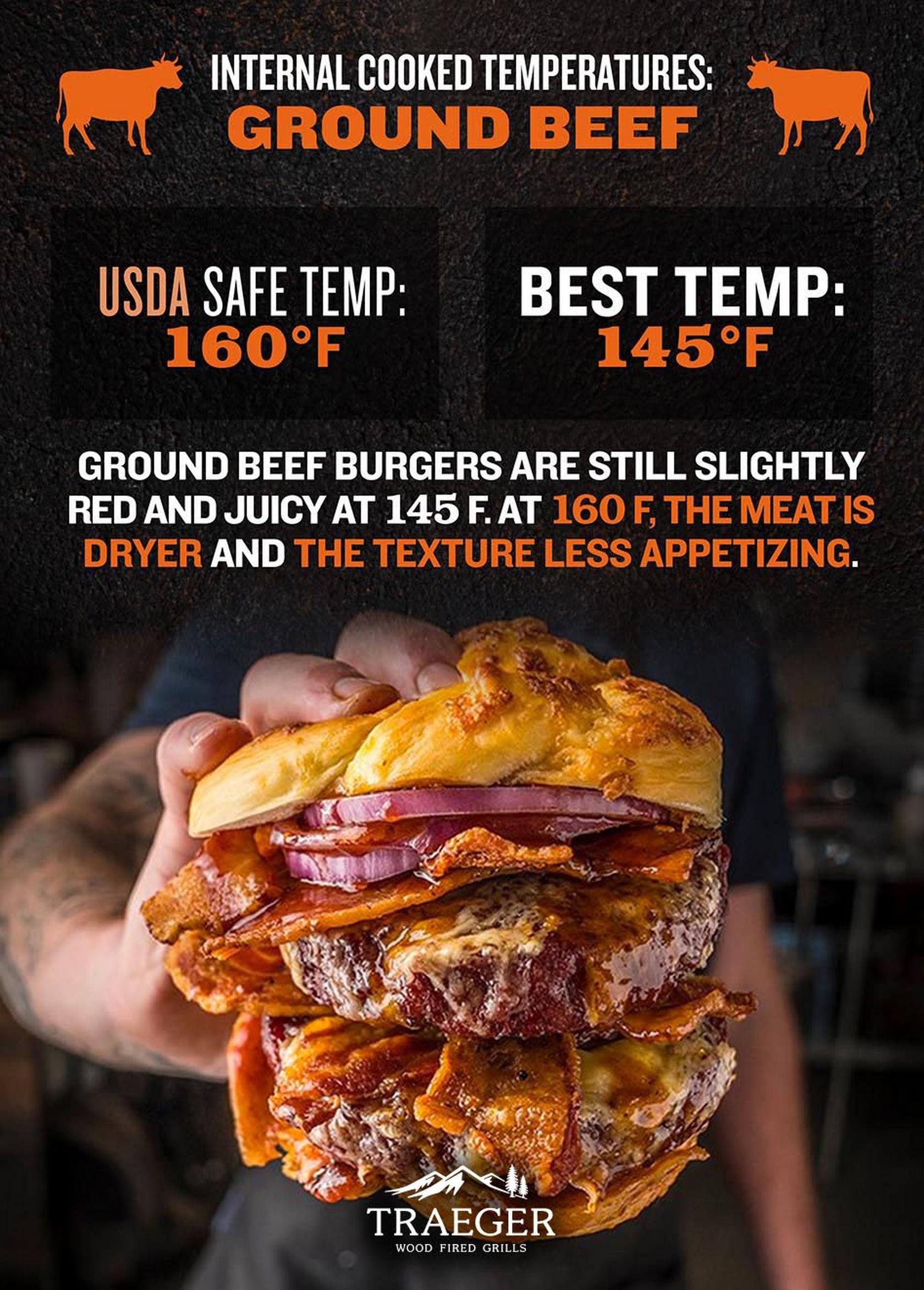
Ground beef normally starts to brown before it’s cooked so color and juices aren’t the best guide, here. The so-called “danger zone” for bacteria ranges from about 40 degrees to 140 degrees Fahrenheit (more on that in a minute).
Translation: Although the USDA recommends a serving temp of 160 degrees for ground beef, you can go a bit lower and still be out of the danger zone. And because we prefer burgers that are still a little bit red and juicy, we’d recommend you aim for an internal temperature of 145 degrees Fahrenheit.
A temperature of 145 degrees will give you a nice medium. Above the USDA’s danger zone for bacteria but slightly below the recommendation of 160 degrees Fahrenheit. If you prefer to play it safe and go for 160 degrees, you’ll end up with well-done, rather chewy, ground beef.
For more tips on burger cooking times and serving temperatures for ground beef patties check out our ultimate guide on How to Grill the Best Burgers.
What Is the Safe Internal Temperature for Steak?
The USDA-recommended safe serving temperature for steak is 145 degrees Fahrenheit. An internal temperature of 145 degrees will earn you a well-done steak, and if you’re dealing with a particularly thick cut, you should be able to retain a healthy pink glow in the middle of your steak at 145 degrees.
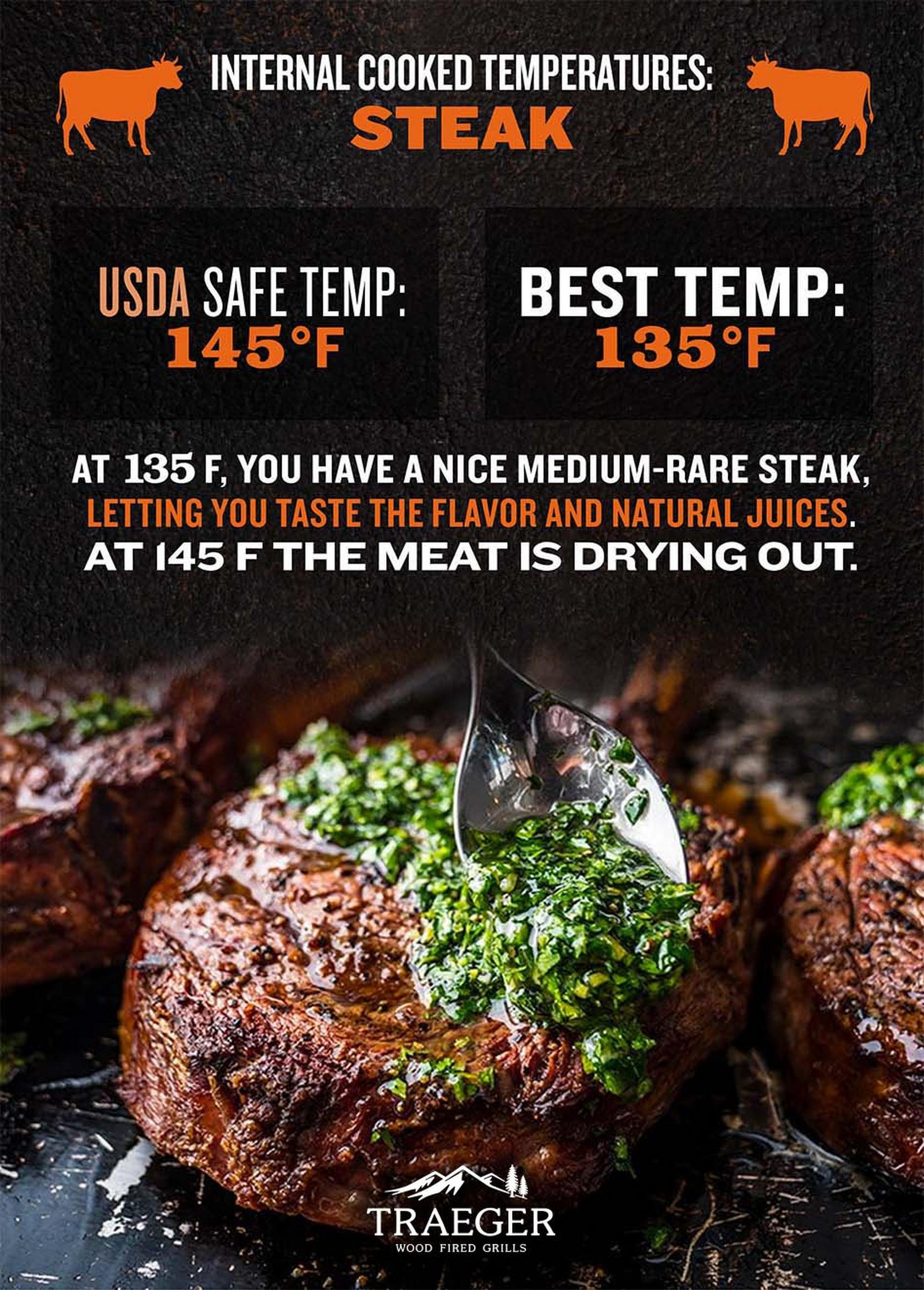
But a well-done steak isn’t going to give you quite as much flavor (and you can kiss that amazing blast of natural juices goodbye). Instead, we recommend aiming for an internal temperature of 130 to 135 degrees Fahrenheit. This temp will land you with a juicy, medium steak – which is how most people order it.
While this is below the USDA recommendation, Scientific American notes that “muscle interiors are sterile and pathogen free” because they haven’t been exposed to any surface bacteria. That’s why most of us are comfortable gambling with a slightly undercooked steak. It’s far less likely to have nasty germs, and (in our humble opinion) it tastes so much better if you preserve some of those natural meaty flavors.
Whether you stick with the USDA on this one or you choose to veer off a bit, bear in mind the lowest recommended internal temperature for steak is 120 degrees Fahrenheit (anything less and it’s not even warm). You should also let your steak rest for a minimum of 3 minutes before carving or consuming.
Want more advice on steak doneness? We’ve got you covered.
What Is the Safe Internal Temperature for Lamb?
The USDA-recommended safe serving temperature for lamb is 145 degrees Fahrenheit. Just like steak, we part company slightly with the USDA when it comes to how we like our lamb.
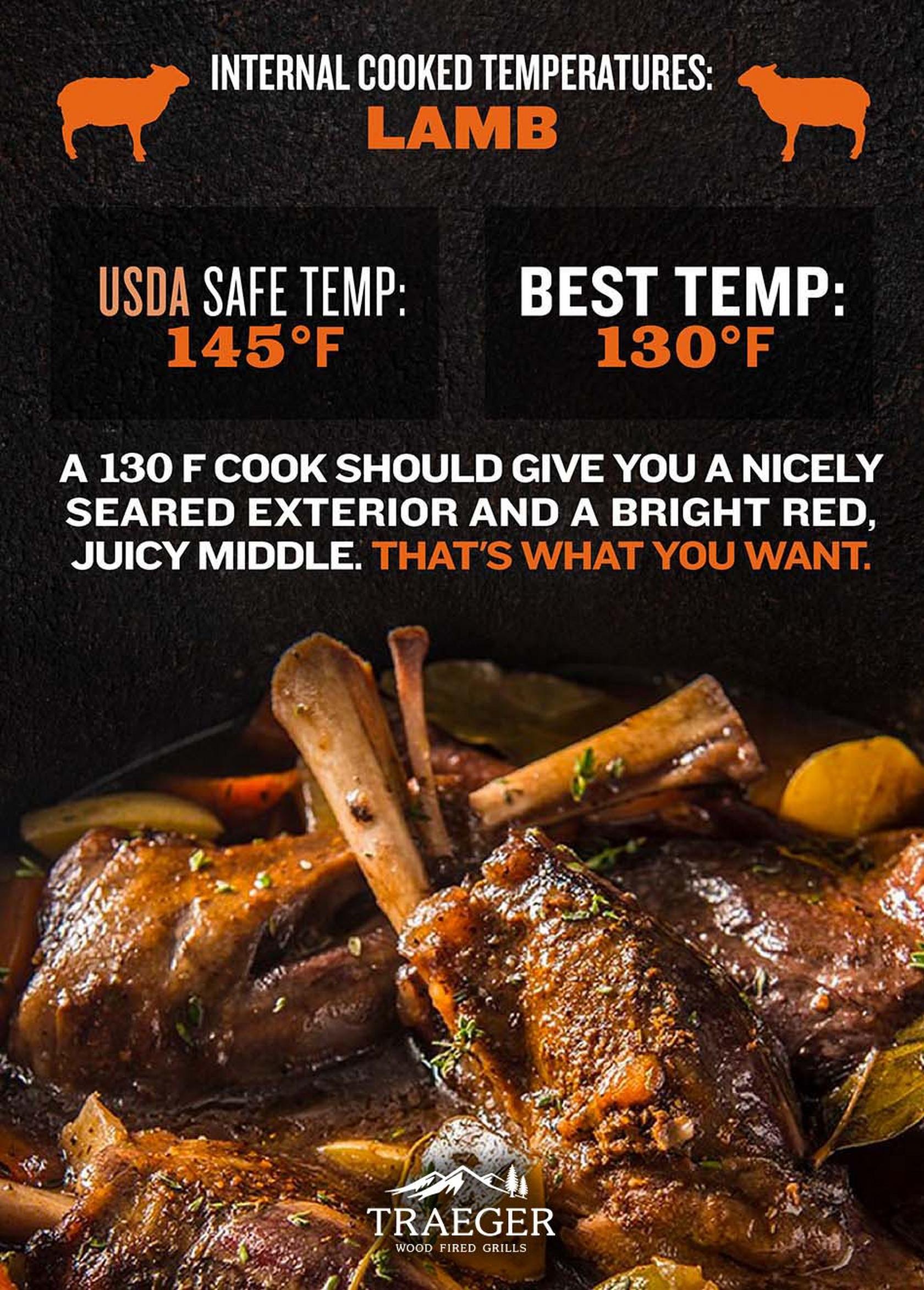
There’s nothing like a tender leg of lamb with a bright red center – which is why our experts at Traeger normally shoot for an internal temperature of closer to 130 degrees Fahrenheit. At 130 degrees, you should end up with a flavor-blasted, medium-rare lamb roast that will stop traffic.
What Is the Safe Internal Temperature for Pork Chops?
The USDA-recommended safe serving temperature for pork chops is 145 degrees Fahrenheit. This internal temperature is the government’s advice for all cuts of pork, and you should observe it closely.
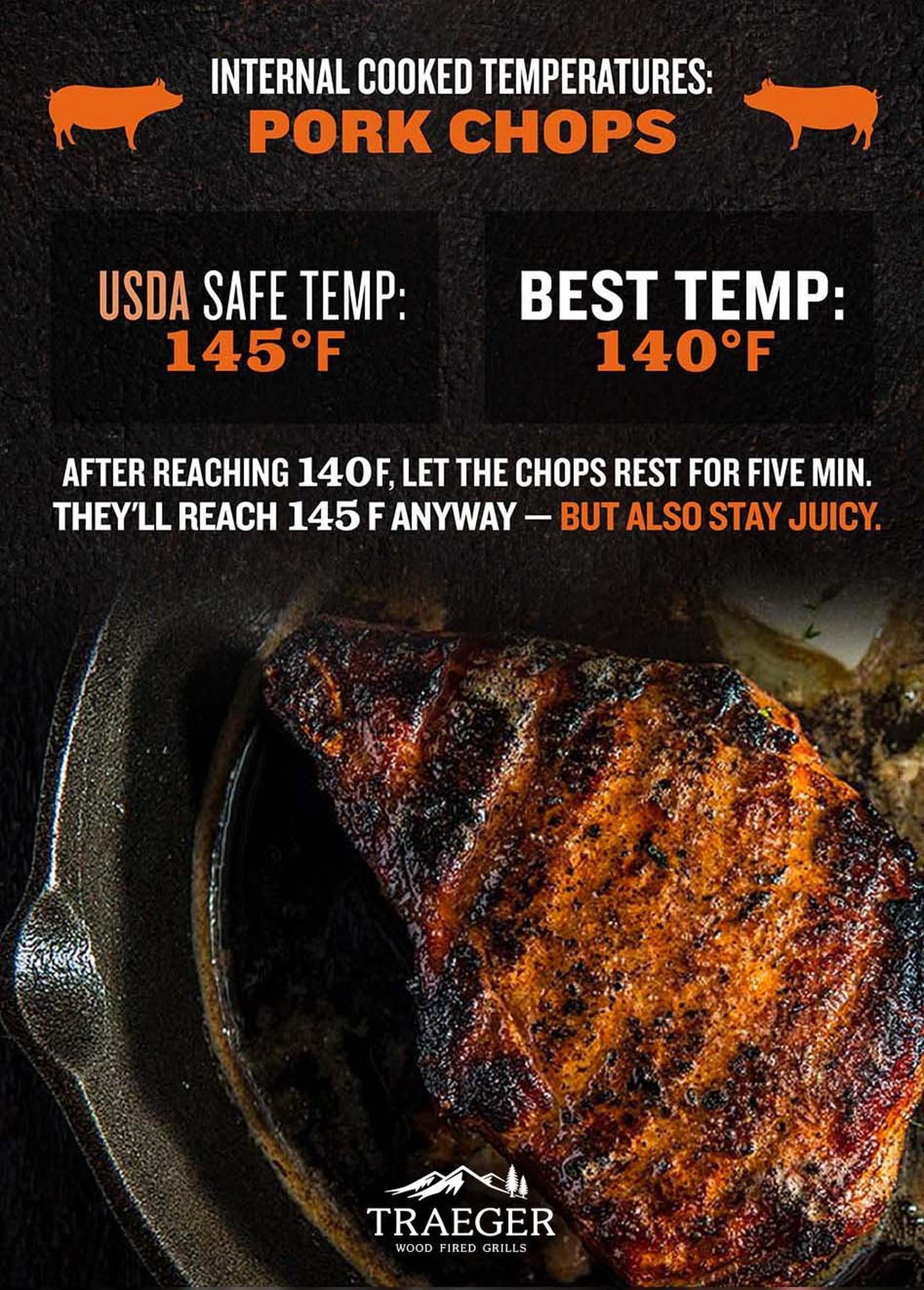
But just because you’re aiming for a final destination of 145 degrees doesn’t mean you can’t play around a bit with your route. For a perfectly seared pork chop, our grill masters recommend you sear on both sides until you’re clocking an internal temperature of 140 degrees.
After that, take your pork chops off the grill to rest for 5 minutes. Your internal temperature will rise to the USDA recommended 145 degrees as the heat continues to work its way through the cut. The result is safe, warm, and seared to the point of deliciousness.
What Is the Safe Internal Temperature for Pulled Pork?
The recommended safe serving temperature for pulled pork is 145 degrees Fahrenheit. This is the minimum internal temperature at which you’re rid of all the harmful bacteria – but when it comes to pulled pork, you should always go hotter. Much hotter.
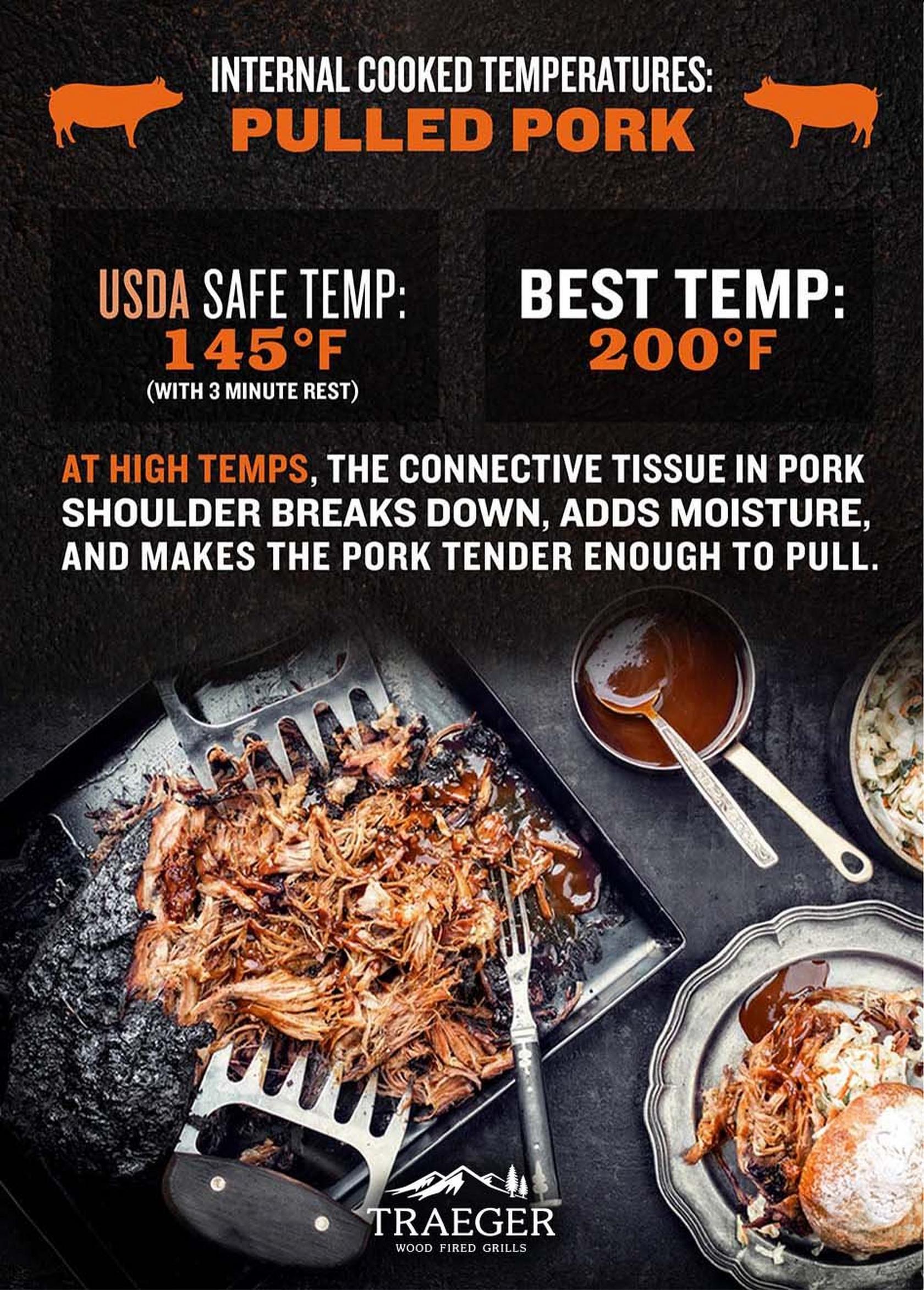
Because the cuts used for pulled pork are rich in natural fats like collagen, you have to bring your pork to a higher internal temperature so that you can break down those fats, dissolve connective tissue, and reap the benefits of a slow-cooked hog.
Instead of 145 degrees, our experts advise you shoot for an internal temperature of 204 degrees Fahrenheit for the ultimate smoked pulled pork. Since thick pork cuts don’t come into contact with direct heat sources on a wood pellet grill, you don’t have to worry about drying out the meat. Here's more info on cooking pulled pork.
What Is the Safe Internal Temperature for Pork Ribs?
The USDA-recommended safe serving temperature for pork ribs is 145 degrees Fahrenheit. But (again) our grilling experts recommend you aim for a hotter temperature to make sure you melt down all the connective tissue into sweet, meaty goodness.
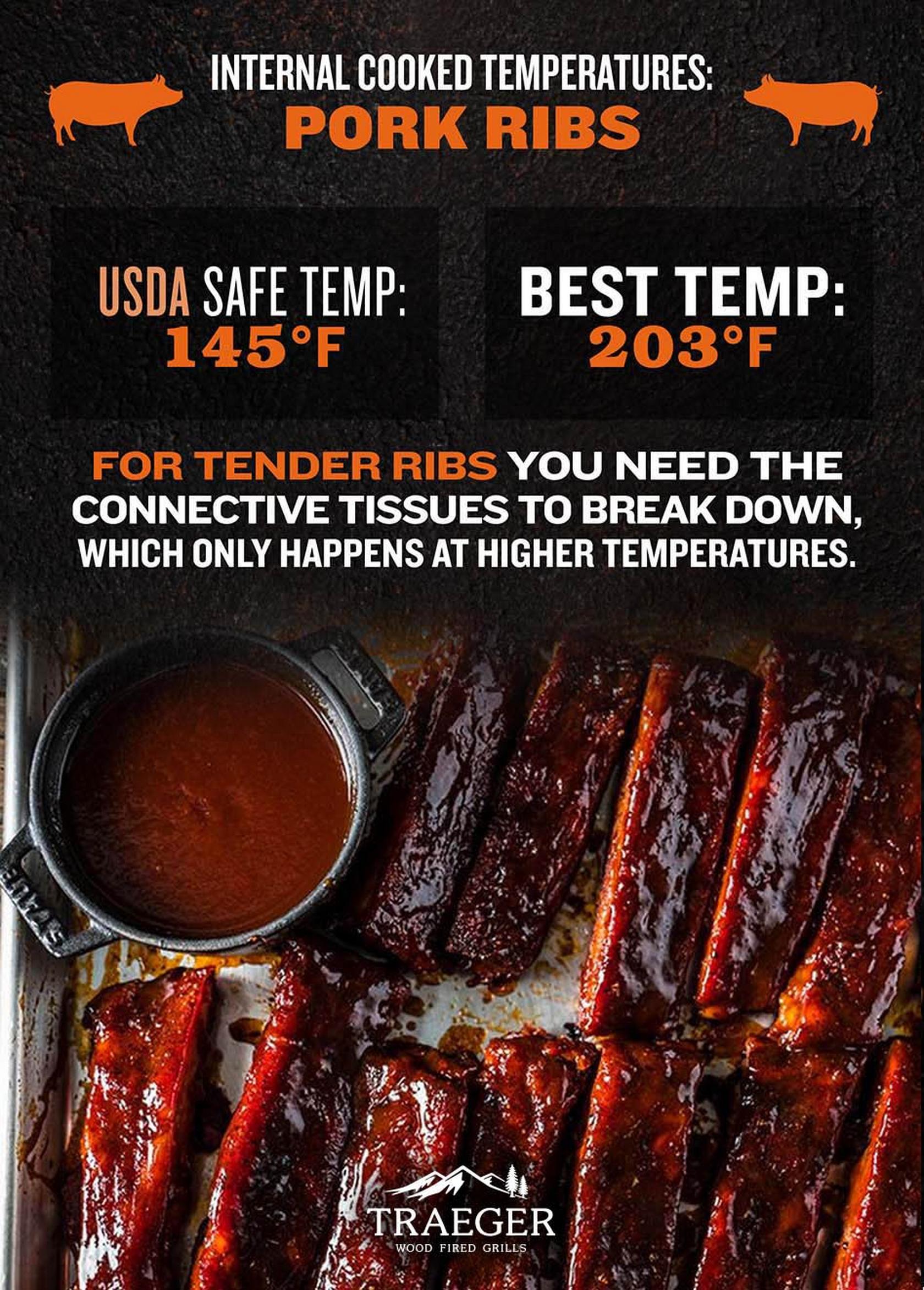
If you’re cooking your ribs low and slow on a wood pellet grill, you can afford to heat things up quite a bit without drying out your pork. That’s why our fool-proof recipe for St Louis BBQ Ribs advises you go for an internal temp of 203 degrees Fahrenheit.
What Is the Safe Internal Temperature for Fish?
The USDA-recommended safe serving temperature for fish is 145 degrees Fahrenheit. Because cuts of fish are more likely to have encountered external bacteria, you don’t want to play around with this one.
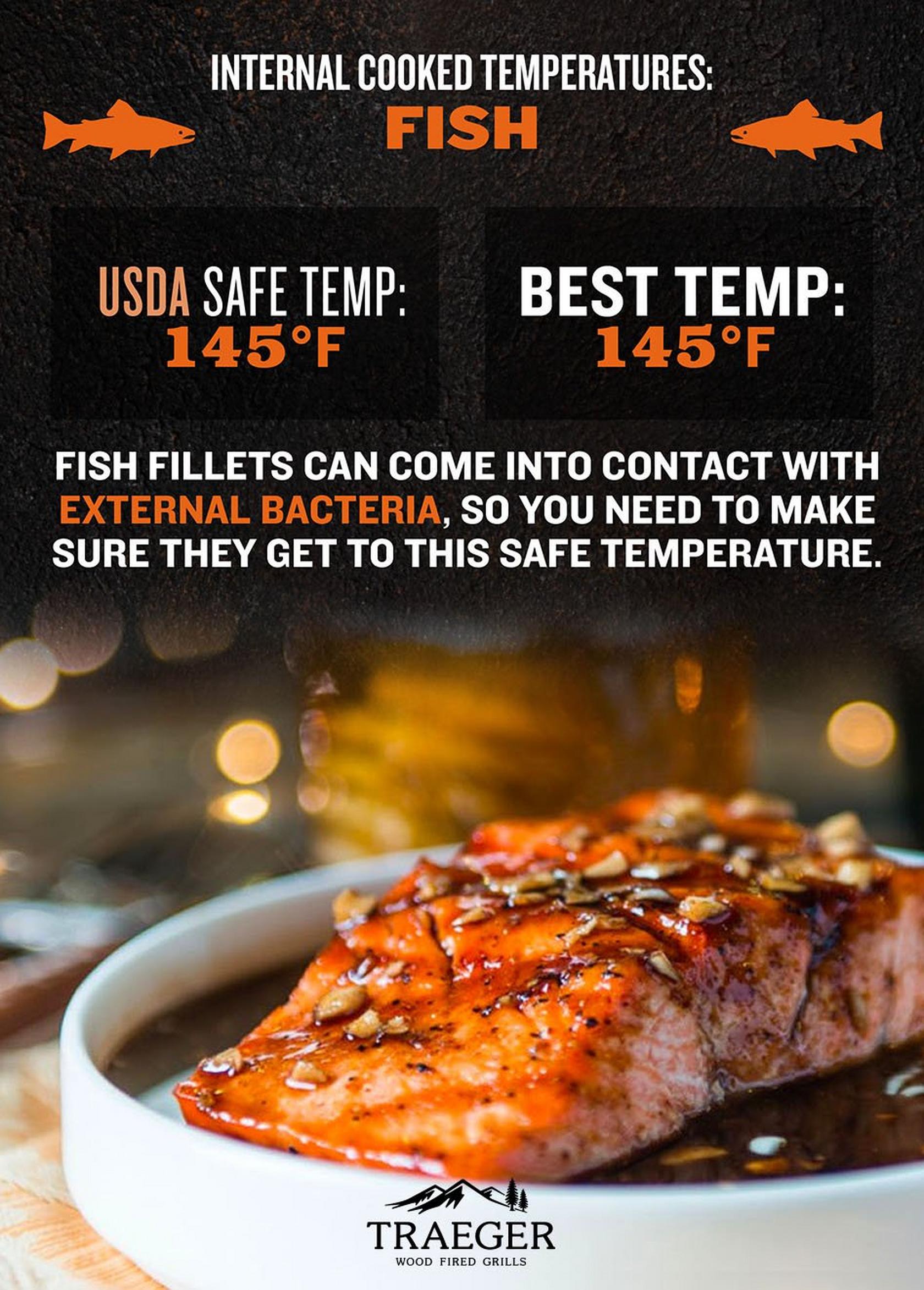
But hey, what fun would life be without a few exceptions to the rule?
This safety guideline of 145 degrees only applies to fish with fins. If you’re cooking shellfish like shrimp, lobster, crab, or scallops, you’re advised to cook until the flesh is pearly or white and opaque.
Clams, oysters, and mussels are even easier. You simply cook them until the shells open. If the shells open, they’re safe to eat. If the shells stay closed during cooking, throw them away, because they may be unsafe to eat.
How to Use a Meat Thermometer
To make sure your meat is safe to eat, you need to keep close tabs on the internal temperature of your cuts. That’s why you should really know how to use a meat thermometer before you start grilling.
There are a few types, but we recommend using an instant-read thermometer. These are super easy to use because all you have to do is insert your thermometer into the meat for an accurate reading in real time. To ensure accuracy, place your thermometer’s probe at least half an inch into your meat, and give it about 10 seconds to get a fair reading.
If you’re using an in-grill or in-oven thermometer, you typically insert the probe at least 2 inches from the center of the largest part of your cut. Make sure it’s not touching any fat, bone, or the pan, or it will totally mess up your reading.
No matter what type of thermometer you have, make sure to test its accuracy beforehand using ice water or boiling water. It’s also important to clean your meat thermometer with hot soapy water after every use to prevent cross-contamination next time it’s used.
What Is the Best Meat Thermometer?
The best meat thermometer to use is going to be an instant-read thermometer. Instant-reads give you quick results (hence the name), and they’re far more accurate with only a 1% margin of error. That means less time tinkering with the grill lid open. It also means peace-of-mind when it comes to safety.
Both digital and dial instant-read thermometers are pretty widely available, but our experts always advise to go digital. We have nothing against old-timey dials, but digital is quicker and leaves zero room for mistakes.
Can You Leave A Thermometer in Meat While It's Cooking?
You might be able to leave a thermometer in meat while it's cooking, depending on the type of meat thermometer.
Most digital instant-read thermometers and dial instant-read thermometers aren’t designed to be left in meat while it’s cooking. On the flipside, pop-up thermometers and thermometer-fork combinations are typically okay to leave in your meat throughout the cooking process.
Understanding Safe Meat Temperature
Ok, so we’ve covered all the safe serving temperatures for your most common meats. But knowing about safe temperature and understanding safe meat temperature are two totally different things, so let’s delve a bit further into why you need to follow all these USDA rules.
What Is the Food Temperature Danger Zone?
The food temperature “danger zone” is between 40 degrees and 140 degrees Fahrenheit. At these temperatures, harmful bacteria grow most rapidly, and can double in about 20 minutes.
How do you avoid it? The USDA advises you to never leave food out of the fridge for more than two hours. If it’s hotter than 90 degrees outside, don’t leave food out for more than one hour. You should also try to keep hot food hot (above 140 degrees) and cold foods cold (below 40 degrees).
Cooking meat at a temperature of at least 325 degrees Fahrenheit will help you steer clear of the danger zone. Store leftovers at temperatures of 40 degrees or below.
What Are Common Types of Foodborne Illness From Meat?
The most common types of foodborne illness from meat are infections caused by Salmonella, E. coli, Yersinia and other types of Campylobacter bacteria. All these bacteria types can go on to cause what people widely refer to as food poisoning with all its nausea and associated symptoms.
Trust us. If you haven’t already experienced it, you do not want a foodborne illness. That’s why we’ve created this huge guide to walk you through the rules on safe serving temperatures. By ensuring you’ve properly cooked your meat outside the danger zone, you’ll decimate any existing bacteria on your cut and drastically reduce your chances of getting sick.
You also shouldn’t wash poultry or meat before cooking it. This is an old wives’ tale a lot of us were told as kids, but washing meat just spreads germs to other foods, utensils, and surfaces. It’s more likely to increase your exposure to harmful bacteria in the long run.
Are Certain Types of Meat More Likely to Cause Foodborne Illness?
There are certain types of meat that are more likely to cause foodborne illness including raw or undercooked poultry, eggs, and shellfish. Beef and pork are typically on the safer end of the spectrum because large cuts of muscle tissue are far less likely to have encountered external bacteria.
The fact of the matter is that although some meats are more likely to make you sick than others, any type of meat can be contaminated in the field, during processing, or at the store. That’s why you shouldn’t play around with safe serving temps. When in doubt, shoot for the USDA recommendations.
If you want a few more facts on foodborne illness, take a look at the CDC’s guide on food poisoning.
That’s pretty much it. We’ve covered the USDA recommendations for the safe serving temps of your most popular cuts, info about bacteria, and all the basic steps you can take to get rid of them. But the journey to grilling epic-ness doesn’t end there.
The USDA is constantly updating its recommendations, and there are quite a few recipes that allow you to tweak internal temps. Keep your ear to the ground, and check back o our Learn articles for more tips and tricks.
Summary
Safe Internal Temperatures for Meat:
- Chicken - 165 °F
- Turkey - 165 °F
- Ground Beef - 160 °F
- Steak - 145 °F
- Lamb - 145 °F
- Pork Chops - 145 °F
- Pulled Pork - 145 °F
- Pork Ribs - 145 °F
- Fish - 145 °F